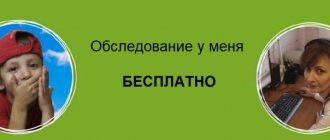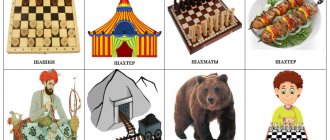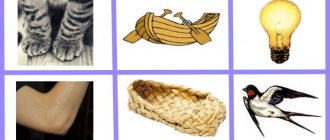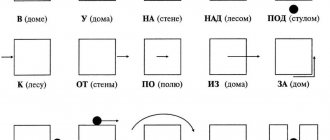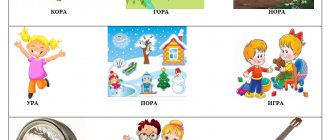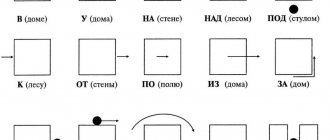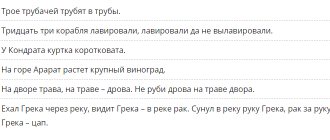Presentation: “Automation of the sound “L” in words using game exercises” - a multimedia guide to automating the sound “L”.
The sound “L” is normally formed in children by the age of 4.5 years. The reasons for the absence or distorted pronunciation of the sound “L” are different. But if your child does not have this sound in his speech by the age of five, then you should think about it.
Performing special exercises (articulation gymnastics) can help you pronounce this sound correctly. If this does not correct the situation, then we recommend that you seek help from a specialist. Sometimes one or two lessons are enough to establish sound.
Next, we proceed to automate the delivered sound in syllables, words, phrases, sentences, and coherent speech. All this material can be found at this link.
Since the automation process usually takes a long time, a huge amount of material is required. All this is so that the child’s interest does not fade away and he does not refuse to study.
It is for these purposes that a PRESENTATION FOR AUTOMATING THE SOUND “L” IN WORDS has been developed.
Benefits of presentations:
- All children love to play on computers and all kinds of gadgets. Therefore, this type of gaming activity will definitely interest them.
- All material and pictures are understandable for children.
- The pictures are arranged in order of difficulty, but do not contain the sound “R”. This is a very important point. Since in most cases, if a child does not say “L,” then the pronunciation of the sound “R” is impaired. And this will only worsen the automation of the “L” sound.
- In the presentation, the child will be able to switch files himself, and this is an additional game moment.
- The presentation is a very accessible educational material that does not require any costs. All you need is a computer, laptop or tablet.
This game guide also presents articulation exercises for the sounds “L”, “L”. They must be carried out before the start of the lesson in order to prepare the child’s speech apparatus to pronounce the sound “L” correctly.
You will find more complete information on performing articulatory gymnastics at the dedicated link.
Presentation: “Automation of the sound “L” in words” has been developed in several versions and is divided into parts. This is done so as not to tire the child with a long lesson. And most importantly, the basic rule is observed - automation of the sound “L” occurs in stages.
It is for these purposes that we have developed a presentation in 4 versions:
- Automation of the “L” sound at the beginning of words
- Automating the "L" sound in the middle of words
- Automation of the "L" sound at the end of words"
- Full version of the presentation (contains all three stages of automating the sound “L”)
Presentation: “Automation of the L sound in words using game exercises” is presented on our website in only one version. This version contains 23 pages on automating the “L” sound at the beginning of words.
We also have presentations on automating the “L” sound in the middle of words, on automating the “L” sound at the end of words, the full version of the presentation. They contain 22, 20, 60 pages respectively.
You can receive these presentations by emailing
You can also write feedback via email. You can find it at the end of each page.
In addition, in the presentation on the automation of the sound “L” you will be able to play educational games and exercises with your baby.
Interactive manual for preschoolers. Automation of sound [l] in words
Multimedia presentation for automating sound [l] in words
Author: Radulova Svetlana Mikhailovna, teacher-speech therapist, Municipal Educational Institution “Bendery Kindergarten No. 9”, Bendery. Description of work: A multimedia presentation was developed for individual lessons with preschoolers who have impaired sound pronunciation. This material will be useful for speech therapists and parents in working with children to automate the sound [l] in words with open, closed syllables and consonant clusters. Goal: automation of the sound [l] in words. Objectives: Practice correctly pronouncing the sound [l] in words.
Practice forming the nominative and genitive plural forms of nouns. Practice the correct formation of the genitive case forms of nouns. Practice agreeing nouns with numerals and possessive pronouns. Practice forming diminutive forms of nouns. Develop logical thinking and attention. Cultivate perseverance, a desire to study, and develop self-control over your speech. In children with general speech underdevelopment, the formation of all components of the speech system is disrupted. In individual lessons, the speech therapist teacher needs to pay great attention to enriching and activating the vocabulary, the formation of grammatical structure, and the development of inflection and word formation skills. Words with automated sounds are introduced into lexical and grammatical exercises. Throughout the entire lesson, the child should have a persistent positive emotional attitude, which is expressed in the desire to study. This is achieved by using game tasks and exercises. Presentation for automating sound [l] in words contains animations and triggers. On each slide in the upper right corner there is a control button: the document in which the task is given. When you click on the text with the task, it disappears. Automation of the sound [l] in words with a closed syllable (slides 2-6).
Slide 2. “Name the pictures” - Pavel asks to name the objects. The child clicks the mouse on the slide and names the pictures: hall, glass, pencil case, station, floor, goal, stake, table.
Slide 3. “Name the pictures” - Pavel asks to name the objects. The child clicks the mouse on the slide and names the pictures: blow, chair, chalk, torch, cauldron, donkey, goat.
Slide 4. “What did Paul see?” The slide has triggers on the pictures: shelf, bun, Christmas tree, lightning, bottle, violet. - Pavel asks riddles: Wooden, long... (shelf), glass, green... (bottle), sweet, soft... (bun), green, prickly... (Christmas tree), fragrant, fragrant... (violet) - Name the objects you saw Paul. The child clicks the mouse on the picture and names: shelf, bun, Christmas tree, lightning, bottle, violet.
Slide 5. Game “The Fourth Wheel” The slide has triggers in the pictures: table, shelf, chair, fork. - Find the extra item and click on the picture. (Fork).
Slide 6. Game “The Fourth Wheel” The slide has triggers in the pictures: wolf, woodpecker, goldfinch, falcon. - Find the extra item and click on the picture. (Wolf).
Automation of the sound [l] in words with an open syllable (slides 7-12).
Slide 7. Game “One and Many” On the slide there are pictures: llama, paw, lamp, boat, magnifying glass, next to which there are images of clouds. - Lada names one object, and you name many of the same objects. The child clicks the mouse on the cloud and names the pictures according to the example: llama - llamas - many llamas paw - paws - many paws lamp - lamps - many lamps boat - boats - many boats magnifying glass - magnifying glasses - many magnifying glasses
Slide 8. Game “Name it kindly” The slide has triggers in the pictures: bench, boat, palm, fist, dove. — Alla is affectionately called Allochka. Name things affectionately. The child clicks on the pictures, which decrease in size, and names: bench - bench boat - boat palm - palm fist - fist dove - dove
Slide 9. “At the Zoo” The slide has picture triggers: llama, horse, elk, donkey, goat, pigeon, falcon. — Mila came to the zoo to photograph animals. Name the animals and birds that Mila saw. (Mila saw a llama, a horse, an elk, a donkey, a goat, a dove, and a falcon).
Slide 10. Game “What’s missing?” The slide has triggers in the pictures: saw, rock, tent, salad, pin, robe. - Click on the picture and tell me what’s missing? (The saw, the rock, the tent, the salad, the pin, and the robe were gone).
Slide 11. “Count the Sharks” The slide shows an image of the ocean. - Click on the slide and count: one shark, two sharks, three sharks, four sharks, five sharks.
Slide 12. Game “The Fourth Wheel” The slide has triggers in the pictures: horse, doll, lamp, shovel. - Find the extra item and click on the picture. (Lamp).
Automation of the sound [l] in words with a combination of consonants (slides 13-15).
Slide 13. “Mine, mine, mine, mine” The slide has picture triggers: globe, doll, dress, apples, ball, strawberry, flag. - Alla names his objects. Click on the picture and name it according to the example: my globe (my doll, my dress, my apples, my ball, my strawberry, my flag).
Slide 14. “Collect apples” The slide has triggers on apples. - Count how many apples Alla has. Click on the apple and count: one apple, two apples, three apples, four apples, five apples.
Slide 15. Game “The Fourth Wheel” The slide has triggers in the pictures: blouse, raincoat, scarf, dress. - Find the extra item and click on the picture. (Handkerchief).
I hope that the material will be useful in the work of teachers.
Presentation on the topic: Automation of sound [l] in words
We recommend watching:
Speech therapy games for preschoolers Do-it-yourself speech therapy board games for kindergarten Interactive manual for kindergarten. Automation of the sound [l] in phrases and sentences Interactive guide for differentiating the sounds [l] - [r] in syllables and words for preschool children
Similar articles:
Speech therapy games for preschoolers and primary schoolchildren
DIY speech therapy games for preschoolers
DIY speech therapy games
Speech therapy game for older preschoolers
Speech therapy game for children 5 – 8 years old “Who is faster”
These are games and exercises:
- “Name and repeat”;
- "Big small";
- “One is many”;
- "The fourth wheel";
- “Let’s do the math.”
These games will help not only automate the “L” sound in words, but also develop the grammatical structure of speech. Children very often make mistakes in the formation of nouns with diminutive suffixes, errors in the formation of plural nouns, in the agreement of nouns with numerals, etc.
These presentations will help you cope with this problem, and will also develop attention, thinking and memory.
Presentation: “Automation of the sound “L” in words using game exercises”, you can receive all its versions by the above mail.
We hope that our presentations will become your good assistants. And automating the sound “L” will not be a boring task, but an exciting game.
Automation of sound L with Smesharikov characters Compiled by Zhukova G.Yu. speech therapist teacher - presentation
Automation of sound L with Smesharikov characters Compiled by Zhukova G.Yu. speech therapist teacher
Look carefully, whose house is this? (Losyasha) (*) Losyasha is a scientist, he knows everything, so guests very often come to him to learn something new and interesting. (*)
Losyash loves when guests come to him and always cooks something tasty for them and sings. To sing along with Losyash, remember the characteristics of the L sound (the tongue is pressed behind the upper teeth (*) - an obstacle, the sound L is a consonant (*), the throat sings - sonorous.) (**)
Lu (4 times) - I’ll escort the guests to the table, Ly - we’ll sit down at the tables together, La - we’ll sit at the table, Lo - how bright it is at the tables. Get your fingers ready - let's begin. But Losyash is very absent-minded, help him sort out the groceries. (*)
Where do you think these products should be placed? (******) What did you put on the shelf? (in the refrigerator, basket). (*)
Then Krosh came to Losyash and said that he was solving a very important case. He must determine what the Hedgehog ate. Listen carefully. (*)
First the Hedgehog ate chocolate, and then an apple. What did he eat later? (apple) (*). Then he ate the object to the right of the apple? (strawberry) (*). What didn't the Hedgehog eat? (sausage)(*). (*)
Oh, and then the Hedgehog came. He began to wonder how he could answer the question with glory alone. He came to Losyash for help. Do you know how? (*)
What kind of ski poles? (*) (ski), straw hat (*) (straw), spruce branch (*) (spruce), tin soldier (*) (tin), light from the moon (*) (lunar), flowers in the meadow ( *) (meadow). (the correct answer is a red note, the incorrect answer is blue). (*)
Then Nyusha came, and not alone. Who is this (*) Donkey. This is the story Nyusha told about him. Listen to him carefully and try to remember. (*)
Once upon a time there lived a donkey. He didn't need a table (**) and a chair (**). He walked in the forest (*), ate grass (*), drank water from puddles (*) and sang to his favorite liver (*) - IA. Do you remember? Try again.(*)
Once upon a time there lived a donkey. He didn't need a table (**) and a chair (**). He walked in the forest (*), ate grass (*), drank water from puddles (*) and sang to his favorite liver (*) - IA. (*)
But the donkey was stubborn and always says the opposite, but can you do that? Do you want to try? The birch (*) has a thin trunk, and the oak (*) (thick), the hare (*) is cowardly - the lion (*) (brave), Shrek (*) strong, Thumbelina (*) (weak), dog (*) well-fed - wolf (*) (hungry), ball (*) light - weight (*) (heavy), stepmother (*) rude - Cinderella (*) (affectionate). (*)
Then Barash came to Losyash. He wanted to plant flowers in the flowerbed for Nyusha. But he wants only plants that have the sound L in their names to grow there. Shall we help Barash? (*)
Gladiolus (*), aster (*), bluebell (*), lily of the valley (*), rose (*), lavender (*). (*…..)
Here Pin joined his friends. He speaks Russian poorly, so he loves to visit Losyash and learn new things. And you can guess which glory Pin initially calls glory. (*)
Define glory at the beginning: sed...(la) (*), fa... (kel) (*), kuk... (la) (*), cream (la) (*), ha... (lat) (*), pi ... (la) (*). (*)
Well, says Losyash, since you are all here, I give you the following task: (*)
Look at the animals. Did you recognize everyone? Name them. Now list the animals from largest to smallest. Slan (***), elk (***), horse (***), squirrel (**), woodpecker (***), swallow (***). (*)
And now a task for your ears. Determine the place of the sound L in glory. (*)
The Smeshariki were a little distracted, but can you complete the task that Losyash gave them? (*)
Shovel (**, ), knot (**), dress (**), flag (**), lace (**), needle (**). (*)
What a great fellow, Smeshariki and you! Remember: done the job, go for a walk! So you played well, now listen to Smesharikov’s song and dance! See you soon


